17 May 2017
lecture series
EIGHT CENTURIES OF THE PRESENCE OF THE ORDER OF PREACHERS IN NAVARRA: FROM THE GOTHIC TO THE BAROQUE PERIOD
Hand in hand with the figurative arts and beyond the Dominican cloisters: devotions
Ricardo Fernández Gracia
Chair of Navarrese Heritage and Art
University of Navarra
Sculpture, painting and engraving were at the service of the Order of Preachers when it came to disseminating devotions proper to their charism, and very often went hand in hand with preaching and certain practices of worship. On this occasion we will refer to those related to the Virgin, which were the ones that were really projected, thanks to the sons of St. Dominic, outside their communities, unlike others that remained within the walls of their cloisters, such as those related to their saints. Devotion to Our Lady of the Rosary, from the 16th century onwards, and later in the 18th century, plenary session of the Executive Council, and devotion to the Virgin of Soterraña, left numerous examples of their roots in Navarre in onomastics, festivals, confraternities of different kinds, the dedications of churches, chapels and hermitages, as well as in the figurative arts.
The Virgin of the Rosary in Navarre
With regard to the rosary, whose foundation is attributed to Saint Dominic, we know that its configuration finalbegan to take shape at the end of the Middle Ages averagethanks to some Dominicans such as Alano de Rupe and the foundation of some confraternities at the end of the 15th century. The 16th century, with everything related to the battle of Lepanto and the institution of its feast day by popes such as Saint Pius V and Gregory XIII, was decisive in everything related to the expansion of the rosary, which became the Marian devotion par excellence. The action of Leo XIII in the 19th century with his two encyclicals would culminate a long history that is still alive today.
Unlike some Marian advocations linked to other religious orders such as the Virgin of Carmen or Our Lady of Mercy, dressed in the habits of Carmelites and Mercedarians, with the admonition against Urban VIII, the Dominicans did not do so with the Virgin of the Rosary who, apart from being one of their signs of identity, deserved to be the patron saint of some of their convents and chapels in their churches. From the convents of the friars of Pamplona, Estella, Sangüesa and Tudela and the nuns of the latter city and the beaterio in Calle Jarauta in the capital of Navarre, the charisma of the preachers and the rosary, at the forefront of devotional practices, spread.
In Navarre, the invocation of the Rosary appears in thirteen parishes: Zabalegui, Imirizaldu, Equisoain, Biurrun, Lazagurría, Corella, Fontellas, Udabe, Sartaguda, Ilúrdoz, Celigüeta, Ostériz and Villava. Among the chapels of great importance, we should mention those of Caparroso and Villafranca, both of which were added to the floors of their parish churches as spatial organisms with their own independence. Gregorio Silanes has counted the number of confraternities in the last third of the 18th century in his doctoral thesis , reaching 270 (121 in the merindad of Pamplona, 71 in that of Sangüesa, 59 in that of Estella, 8 in that of Olite and 11 in that of Tudela). subjectSome exceptions were of a professional or guild nature, while the vast majority of them were strictly devotional. Of the former, we can cite those of the cutters of Pamplona, the pelaires of Estella and the tailors of Fitero. As for the establishment of the majority, the iter for their establishment was generally that of a preaching by a Dominican friar from one of the convents established in Navarre, who went to a village and, after the appropriate preaching, urged the establishment of the confraternity. An example of this is what happened in Olite with the protagonism of the man who would later be called the apostle of Charcas in Peru, the bridging friar Vicente Bernedo, who came to the town for this purpose. The contemporary chronicle tells us what happened: "On the 24th of June 1592, the day of St. John the Baptist, a Dominican priest called Fray Vicente Bernedo, from Puente la Reina, preached in San Pedro in this town of Olite, who showed licenceof the Vicar General to establish the brotherhood of the Holy Rosary and the Bull of the General of the Order and licenceof the Pope, and among other things he said that he set his main intention to establish the brotherhood of Our Lady of the Rosary in this town of Olite. He preached the graces and indulgences that the confraternities of the said confraternity gain and in the afternoon of the said day the chapter met, the vicar being Don Diego Bazán y Ezcaray, and in agreement they all asked the said Father Bernedo, together with the mayor, who was Juan de Huarte, and the aldermen of the said town, and they pointed out the chapel of Nuestra Señora del Campanal and the holy image of Nuestra Señora that is on the said altar. And an order was made to that effect. Don Sancho del Salto was appointed abbot of the said confraternity. A book of members was drawn up". For years before, at least as early as 1584, a formby Tomás Porralis was already in print to facilitate and standardise the founding of the confraternities. The devotional internshipincreased following the pastoral visits made by the bishop of Pamplona, Fray Pedro de Roche, from 1675 onwards.
The confraternities celebrated their feast, according to their means, with all the elements of extraordinary festivities, with bonfires, gunpowder, music and the ringing of bells. In Pamplona, the confraternity re-founded in the Dominicans in 1722, organised annual cuestaciones, cloister processions and a general procession through the city. Its confraternities took special care of other aspects related to the worship of their patron saint and patron saint. In 1724-1725, they commissioned a gilded litter, which was made by Fermín de Larráinzar and José García position. The cathedral's music chapel attended the high mass on the day of the Virgin, the siesta and the evening procession, in which carols were performed. Rockets were also purchased for the eve of the feast, which were bought from the Lesaca family, first from José and then from his son Manuel, from the middle of the century onwards.
We cannot fail to mention among the propaganda machinery the editions of the novenarios of the Navarrese presses with the gozos that were quickly set to music by different musicians and also sung with popular melodies. It is also worth mentioning the great impact of the voluminous book published in the capital of Navarre by the Pamplona conventual friar and preacher Fray Miguel de San Clemente graduateFragancias del Rosario de la Virgen María (Fragances of the Rosary of the Virgin Mary , 1726).
As for images of the Virgin of the Rosary, it should be noted that they are not documented in the territory of the Foral until the 16th century, although there are some medieval carvings to which a rosary was added and thus baptised with the desired invocation (Puente la Reina, Sansol, etc.). Among the most outstanding are those of Pamplona, the work of Miguel de Espinal (1562), Biurrun and Barasoain with a Romanesque aesthetic and that of Corella, from the second half of the 17th century. The best group is made up of a series of pieces imported from the Court and made by Luis Salvador Carmona and his circle, including those from Falces, Santesteban, Arizcun, Lecároz, Elizondo, Sesma and Azpilcueta. The latter, dated 1752, has the epistolary testimony of someone who saw it in the sculptor's workshop, praising its quality. For the most part, the modelpresents a standing image, with a rhomboidal shape due to the opening of its cloak with theatrical folds, holding the Infant Jesus and the rosary.
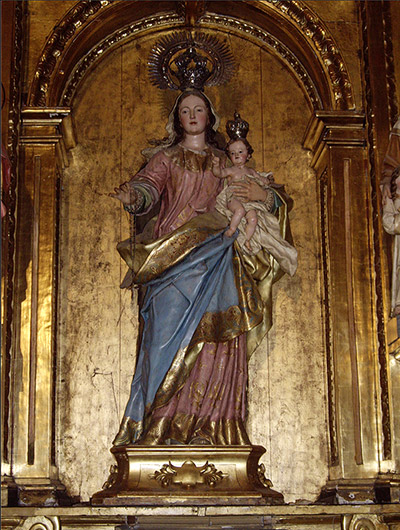
Our Lady of the Rosary (Elizondo)
Luis Salvador Carmona. Madrid, ca. 1750
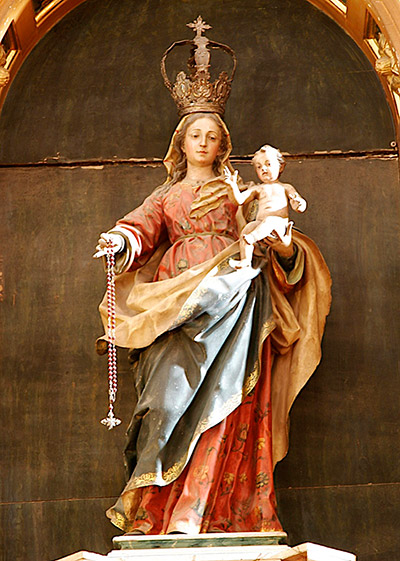
Our Lady of the Rosary (Sesma).
Circle of Luis Salvador Carmona. Madrid, mid-18th century
The most exceptional piece of all dates from 1749, venerated in its altarpiece in the parish church of Irurita and made by the sculptor Juan Domingo Olivieri in Madrid, commissioned by the Goyeneche brothers, treasurers of the royal palace, for the devotion of their mother, María Martiarena, who had lived in the Jauregia palace in the aforementioned town since her daughter María Teresa married the owner of the palace. The academic models left their mark on the local sculptors who would recreate them, with greater or lesser success, throughout the region. Miguel de Zufía, Francisco Pejón, Lucas de Mena and other masters active in the second half of the 18th century left signs of their inspiration in the late Baroque and academic models.
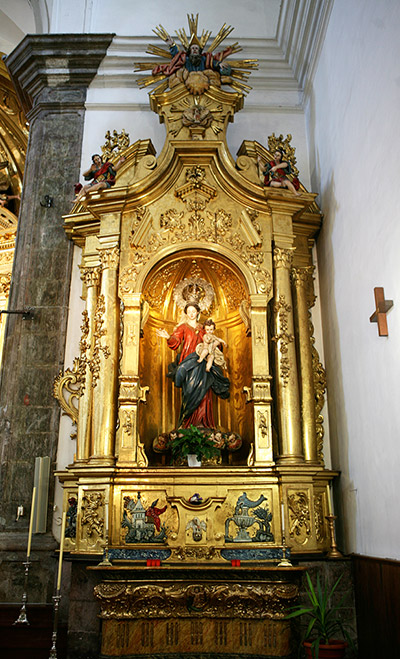
Altarpiece of the Virgin of the Rosary (Irurita), 1775
Titular image by Juan Domingo Olivieri. 1749
At the end of the century other types arrived with the image seated with the Child on his lap, generally on a cloud and with very rich rococo aesthetics. subjectThe Azpilcueta and Errazu carvings, a gift from Felicia Gastón de Iriarte (1725-1799), married to Francisco Indaburu y Borda (†1774), treasurer to Queen Isabella of Farnese, belong to this period, and were made in 1776.
All these images had altarpieces, mostly Baroque. The classicist altarpieces of Biurrun, San Pedro de la Rúa in Estella (belonging to the Dominicans of the same city), Valtierra, and the Solomonic altarpieces of the Rosario de Corella, Dominicans of Pamplona and Dominicas of Tudela belong to the 17th century. In the 18th century, apart from several examples belonging to the decorative Castilian style (Ablitas, Villafranca, Arróniz, Larraga and Tafalla), those of Lecároz and Azpilcueta, the work of Silvestre de Soria, and those of Falces, Lesaca, Cáseda, Puente la Reina, Roncal and Ustárroz, works by local masters and others who came from Aragón or Guipúzcoa, stand out. In most of them we find the image of Santo Domingo de Guzmán, either in the attic or in one of the side streets, as if to record the popular belief that the rosary was founded by the saint and also to testify to the relationship with the Order of Preachers.

Altarpiece of the Virgin of the Rosary (Lesaca)
Tomás de Jaúregui, 1754
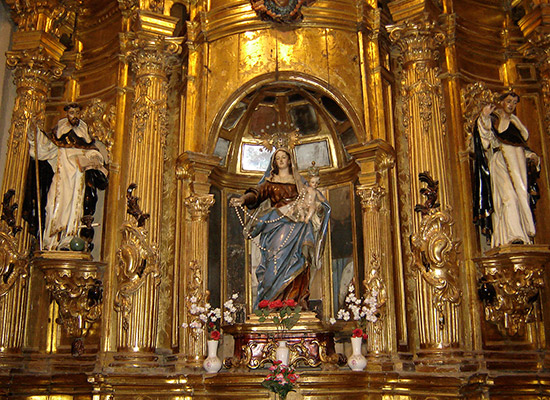
Altarpiece of the Virgin of the Rosary (Falces)
Dionisio de Villodas, ca. 1760
As for the engraved prints, we know that they arrived from abroad and other Spanish regions. Of the images from Navarre, only the one from the Dominican convent in Pamplona was transferred to the burins on two occasions in the 18th century, by means of the intaglio print procedure, and on another, in the 19th century, in a large lithograph. Scapulars were also made in the 18th century by order of the same convent.
Images of the Soterraña: against lightning and thunderbolts
The relationship with the Segovian sanctuary of the Virgin of Nieva or Soterraña was secular for Navarre, as Queen Doña Blanca was buried there. However, it was from the third decade of the 18th century onwards that the wonders worked through the intercession of the Virgin of Soterraña were spread throughout many territories and, of course, in Navarre by various means, leading to the arrival of several of her images to implore her special protection against fire, lightning and flashes of lightning, as she had been invoked for some time in many other places. It seems that all this renewed fervour reached a real milestone in the capital of Navarre in 1732, on the occasion of a fire at the gunpowder mill and the incombustión of a statue of the Soterraña. A similar prodigy with the same image was repeated on 17 March 1733 in the same establishment in another dreadful fire and explosion, which together with other miraculous events narrated by Father Barcáiztegui, prior of the Dominican convent in Pamplona, in 1733, brought about a devotional frenzy towards the Marian devotion in these lands.
One of the first candlestick images arrived in Pamplona on 31 May 1733 and was transferred to the Dominicans on 14 July. Its altarpiece was made the following year under the auspices of the mayor of the Court, Don José Ezquerra. The first canvas with the vignettes of the legendary story arrived in the Navarrese capital at the end of May 1733, destined for the parish church of San Juan in Pamplona Cathedral, accompanied by the certification that the original by Nieva had been touched, an essential condition for the images, engravings and medals to have the powers against lightning and flashes of lightning. The rich frameworkwith its pavilion was made at positionby José Pérez de Eulate, commissioned by the parishioners of San Juan.
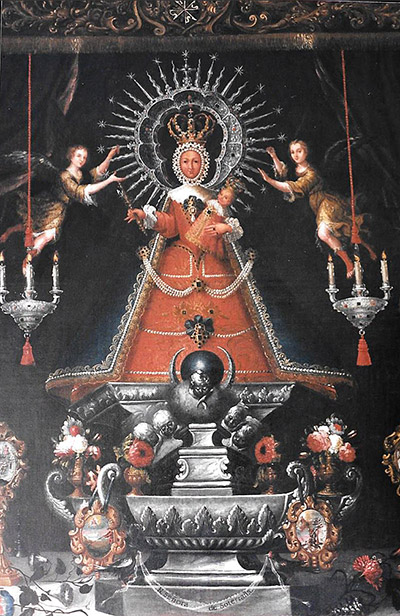
Our Lady of Soterraña
Convent of Benedictine Sisters of Alzuza
Madrid School, mid-18th century
Numerous villages have her image, with internshipstanding out among the counties of Valdizarbe. Viana brought it in 1737, Los Arcos and Valtierra in 1742, Puente la Reina in 1748 and Uterga and Muruzábal in 1802. All these candelabra images have their own particular history and specific reasons for their arrival. The one in Valtierra, for example, was brought as a result of a lightning strike that killed the parish priest's brother, leaving the latter lame. A little less than a century ago, Félix Zapatero still records the following testimony about its worship and devotion in Valtierra, especially in times of heavy cloud cover: "When a storm threatens the town, any neighbour enters the church in moments of fearful anguish and unceremoniously takes the glorious image to the portico of the church, where, once the storm has passed, it returns to its altar accompanied by the chapter and the faithful with the ceremonial ritual".
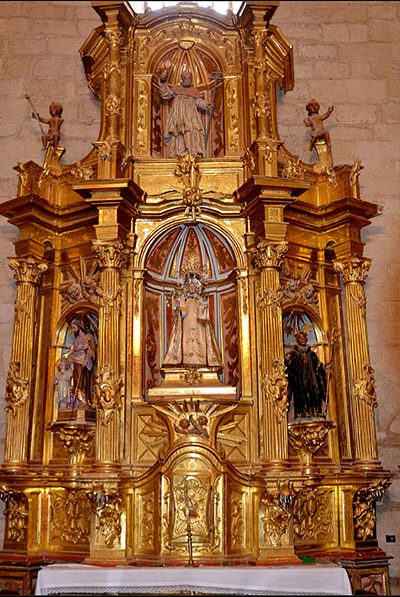
Altarpiece of the Virgen de Soterraña (El Busto)
Miguel López de Porras and Antonio Izaguirre, 1769-1772
